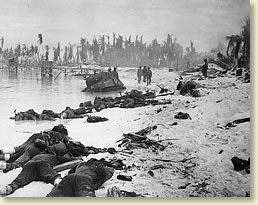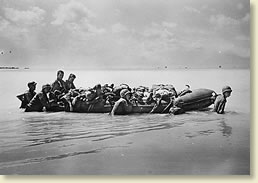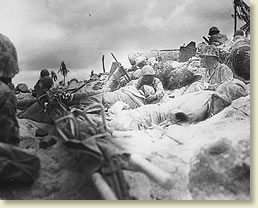|
The Bloody Battle of Tarawa, 1943
Tarawa is an atoll located approximately 2,500 miles southwest of Hawaii. It consists of a series of coral islets that stretch through the ocean in a hook-like fashion. The military importance of Tarawa lay in its strategic location at the gateway of the US drive through the central Pacific towards the Philippines.

Bodies of dead Marines litter the beach
after the battle |
The largest of Tarawa's islets is Betio measuring less than 3 miles in length
and 1/2 mile in width. Here, the Japanese built an airstrip defended by 4,700
troops dug into a labyrinth of pillboxes and bunkers interconnected by tunnels
and defended by wire and mines. The task of dislodging this force fell to the
Marines of the 2nd Division. The resulting struggle produced one of the fiercest
and bloodiest battles in Marine Corps. History
The landings began on November 20 and immediately ran into trouble. Coming in at low tide, the assault boats were forced to disgorge their men far from shore. Wading through waist-deep water over piercing, razor-sharp coral, many were cut down by merciless enemy gunfire yards from the beach. Those who made it ashore huddled in the sand, hemmed in by the sea to one side and the Japanese to the other.
The next morning, reinforcements made the same perilous journey bringing with them tanks and artillery. By the end of the day the Marines were able to break out from the beach to the inland. The fierce combat continued for another two days.
The cost of victory was high for the Marines who suffered nearly 3,000 casualties. The toll was even higher for the Japanese. Of the 4,700 defenders, only 17 survived. Their willingness to fight to the last man foreshadowed the fierceness of the battles to come.
Robert Sherrod was a seasoned war correspondent having covered the Army campaign in the Aleutian Islands and the Navy raid on Wake Island. However, nothing from these experiences prepared him for the brutal terror of Tarawa. His observations of one of the most costly battles in US Marine Corps history were published as a book in early 1944.
In the early hours of November 20, Sherrod was among a contingent of Marines aboard a Navy transport - the Blue Fox, - waiting for the order to board a landing craft for the beach. We join his story as the bombardment of the island begins:
"Now, at 0505, we heard a great thud in the southwest. We knew what that meant. The first battleship had fired the first shot. We all rushed out on deck. The show had begun...
Within three minutes the sky was filled again with the orange-red flash of the big gun, and Olympus boomed again. The red ball of fire that was the high-explosive shell was again dropping toward the horizon. But this time there was a tremendous burst on the land that was Betio. A wall of flame shot five hundred feet into the air, and there was another terrifying explosion as the shell found its mark. Hundreds of awestruck Marines on the deck of the Blue Fox cheered in uncontrollable joy...
The next flash was four times as great, and the sky turned a brighter, redder orange, greater than any flash of lightning the Marines had ever seen. Now four shells, weighing more than a ton each, peppered the island. Now Betio began to glow brightly from the fires the bombardment pattern had started.

Marine wounded are floated out
to waiting ships for treatment |
That was only the beginning. Another battleship took up the firing - four mighty shells poured from its big guns onto another part of the island. Then another battleship breathed its brilliant breath of death. Now a heavy cruiser let go with its eight-inch guns, and several light cruisers opened with their fast-firing six- inch guns. They were followed by the destroyers, many destroyers with many five-inch guns on each, firing almost as fast as machine guns. The sky at times was brighter than noontime on the equator. The arching, glowing cinders that were high-explosive shells sailed through the air as though buckshot were being fired out of many shotguns from all sides of the island. The Marines aboard the Blue Fox exulted with each blast on the island...
The first streaks of dawn crept through the sky. The warships continued to fire. All of a sudden they stopped. But here came the planes-not just a few planes: a dozen, a score, a hundred. The first torpedo bombers raced across the smoking conflagration and loosed their big bombs on an island that must have been dead a half hour ago! They were followed by the dive bombers, the old workhorse SBD's and the new Helldivers, the fast SB2C's that had been more than two years a-borning. The dive bombers lined up, many of thousands of feet over Betio, then they pointed their noses down and dived singly, or in pairs or in threes. Near the end of their dives they hatched the bombs from beneath their bellies; they pulled out gracefully and sailed back to their carriers to get more bombs. Now came the fighter planes, the fast, new Grumman Hellcats, the best planes ever to squat on a carrier. They made their runs just above the awful, gushing pall of smoke, their machine guns spitting hundreds of fifty-caliber bullets a minute.
Surely, we all thought, no mortal men could live through such destroying power.
Surely, I thought, if there were actually any Japs left on the island (which I doubted strongly), they would all be dead by now."
At 0635, Sherrod and a 30-man, Marine assault force board a Higgins landing craft and head for the enemy beach. It takes an hour and a half for the landing craft to reach its rendezvous point off the beach where it joins other assault boats for the landing
It is here that Sherrod gets his first warning that something is going terribly wrong with the attack. He can see no landing craft on the beach - four assault waves should have previously gone ashore. At this point, the commander of the landing craft announces that he can go no further as the water is too shallow. The assault team will have to transfer to a tank-like amphtrack for the rest of the journey. We rejoin Sherrod's account as the Marines scramble aboard the amphtrack under intense enemy machinegun fire:

Amphtrack |
"We jumped into the little tractor boat and quickly settled on the deck. 'Oh, God, I'm scared,' said the little Marine, a telephone operator, who sat next to me forward in the boat. I gritted my teeth and tried to force a smile that would not come and tried to stop quivering all over (now I was shaking from fear). I said, in an effort to be reassuring, 'I'm scared, too.' I never made a more truthful statement in all my life.
Now I knew, positively, that there were Japs, and evidently plenty of them, on the island. They were not dead. The bursts of shellfire all around us evidenced the fact that there was plenty of life in them!... After the first wave there apparently had not been any organized waves, those organized waves which hit the beach so beautifully in the last rehearsal. There had been only an occasional amphtrack which hit the beach, then turned around (if it wasn't knocked out) and went back for more men. There we were: a single boat, a little wavelet of our own, and we were already getting the hell shot out of us, with a thousand yards to go. I peered over the side of the amphtrack and saw another amphtrack three hundred yards to the left get a direct hit from what looked like a mortar shell.
'It's hell in there,' said the amphtrack boss, who was pretty wild-eyed himself. 'They've already knocked out a lot of amphtracks and there are a lot of wounded men lying on the beach. See that old hulk of a Jap freighter over there? I'll let you out about there, then go back to get some more men. You can wade in from there.' I looked. The rusty old ship was about two hundred yards beyond the pier. That meant some seven hundred yards of wading through the fire of machine guns whose bullets already were whistling over our heads.
The fifteen of us - I think it was fifteen - scurried over the side of the amphtrack into the water that was neck-deep. We started wading.

Marines hunker down at the seawall |
No sooner had we hit the water than the Jap machine guns really opened up on us. There must have been five or six of these machine guns concentrating their fire on us... It was painfully slow, wading in such deep water. And we had seven hundred yards to walk slowly into that machinegun fire, looming into larger targets as we rose onto higher ground. I was scared, as I had never been scared before. But my head was clear. I was extremely alert, as though my brain were dictating that I live these last minutes for all they were worth. I recalled that psychologists say fear in battle is a good thing; it stimulates the adrenalin glands and heavily loads the blood supply with oxygen.
I do not know when it was that I realized I wasn't frightened any longer. I suppose it was when I looked around and saw the amphtrack scooting back for more Marines. Perhaps it was when I noticed that bullets were hitting six inches to the left or six inches to the right. I could have sworn that I could have reached out and touched a hundred bullets. I remember chuckling inside and saying aloud, 'You bastards, you certainly are lousy shots.'
After wading through several centuries and some two hundred yards of shallowing water and deepening machinegun fire, I looked to the left and saw that we had passed the end of the pier. I didn't know whether any Jap snipers were still under the pier or not, but I knew we couldn't do any worse. I waved to the Marines on my immediate right and shouted, 'Let's head for the pier!' Seven of them came. The other seven Marines were far to the right. They followed a naval ensign straight into the beach - there was no Marine officer in our amphtrack. The ensign said later that he thought three of the seven had been killed in the water."
References:
This eyewitness account appears in: Sherrod, Robert, Tarawa: the Story of a Battle (1944); Potter, E.B. and Nimitz, C.W., Triumph in the Pacific (1963).
How To Cite This Article:
"The Bloody Battle of Tarawa, 1943" EyeWitness to History, www.eyewitnesstohistory.com
(2003).
|






